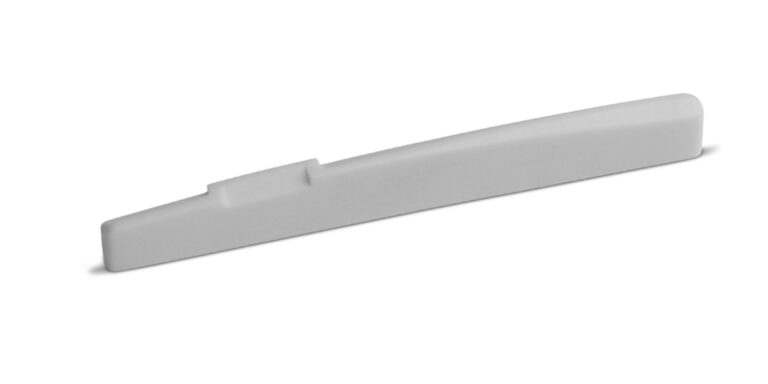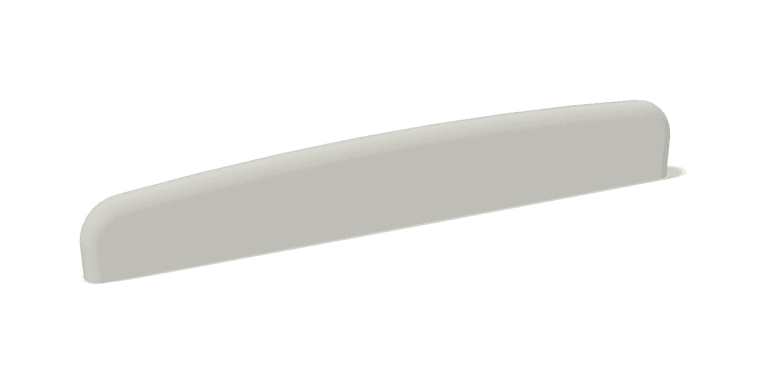Find the Right Saddle for Your Eastman® Acoustic Guitar
Are you in need of an Eastman steel string acoustic guitar saddle? Eastman has only been making flat-top steel string guitars since 2008, but has gained a reputation for making quality instruments. Finding the correct saddle for your Eastman can be a bit difficult because there’s no single saddle size for all Eastman guitars.
This article provides tips on finding the right saddle for your Eastman flat top steel string acoustic guitar, but we advise that you also measure your guitar’s current saddle and saddle slot for a proper fit. If you are not the original owner, at some point someone may have installed a different saddle or have adjusted the saddle slot, producing different specs from the factory’s.
Step One: Measure Saddle Length
From the factory, almost all Eastman acoustic guitars have a 12 inch fretboard radius. Please note that if you are not the original owner, another neck may have been installed at some point. You may want to check the fretboard radius with a gauge.
However, saddle length will vary. A large number of Eastman models will have a B compensated with slanted bass saddle – more on this in the next section. However, this saddle type length will vary, typically between 69 and 71 mm. In our experience, models made before 2022 tend to have 69 mm long saddles, and models built after 2021 tend to have 71 mm long saddles, please but please measure your saddle slot. Please see our bone saddles for Eastman guitars for options in both lengths.
Your saddle may be longer than 71 mm as well, particularly if you have a through saddle – discussed later.
Step Two: Determine Saddle Type
Eastman steel-string acoustics often have one of the three below saddle types.
B Compensated with Slanted Bass
A large number of Eastmans have a B compensated with slanted bass saddle. These saddles are often 69 mm or 71 mm long – please measure your saddle slot before ordering a replacement. They are typically 3.2 mm thick and have a 12 inch radius. Height for models without undersaddle pickups is tall – often around 11 mm. Models with undersaddle pickups often have saddles around 9 mm tall.
At first glance, this saddle type might look just like the Taylor B compensated saddle. However, there are a number of key differences. First, the Taylor B compensated saddle is forward line B compensated – please see our Guide to B Compensated Saddles for more information. Second, the Taylor saddle has a 15 inch top radius. Third, the Taylor saddle is 72 mm long.

Non-Compensated Saddle
Some Eastman parlor guitars have a center line non-compensated saddle, along with a pyramid bridge. Please see our Guide to Non-Compensated Saddles for more information. These center line non-compensated saddles typically have a 3.2 mm thickness and 12 inch radius. Length can vary from 69 to 71 mm, so please measure your current saddle before ordering. See our Non-Compensated Bone Saddle for Some Eastman Parlor Guitars for a 71 mm long bone version.



Relative to the non-compensated saddle, the B compensated with slanted bass saddle will put the treble E and G strings forward, and the B, A, and bass E strings backward. Only the D string stays in the same position on both saddles. This shift will affect the intonation for those strings, but could be a positive or negative effect. Guitar builders consider saddle angle, scale length, string spacing, string gauge, and other factors to determine saddle compensation pattern. Replacing a non-compensated saddle with a compensated saddle could have a negative impact on your intonation, particularly if your string spacing does not match the saddle compensation pattern.
Through Saddle
Many, but not all, of the double O Eastman guitars have a through saddle, which will go entirely through the bridge. This type of saddle requires significant skill and knowledge for replacement. We advise that you do not attempt DIY replacement and instead hire a professional guitar technician.
Which Saddle Does Your Eastman Need?
Still wondering which type of saddle your Eastman acoustic guitar needs? Please contact us with all of the following information:
• Guitar Year, Model, Fretboard Radius
• Current Saddle Length, Height, Thickness – Must Be Measured with a Caliper
• Guitar Saddle Slot Length, Thickness (if different from saddle specs)
• Bass/Treble Edge Height Difference
• Current Saddle Compensation Pattern (please send a picture if you are not sure what type you have)
• String Spacing at the Bridge
We will respond within 48 hours.
